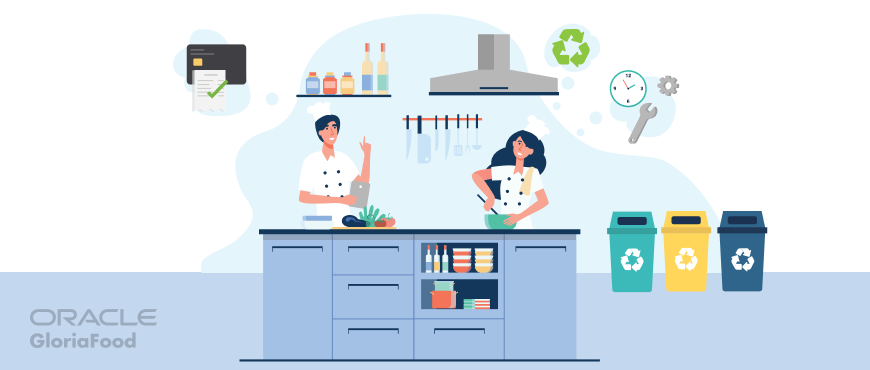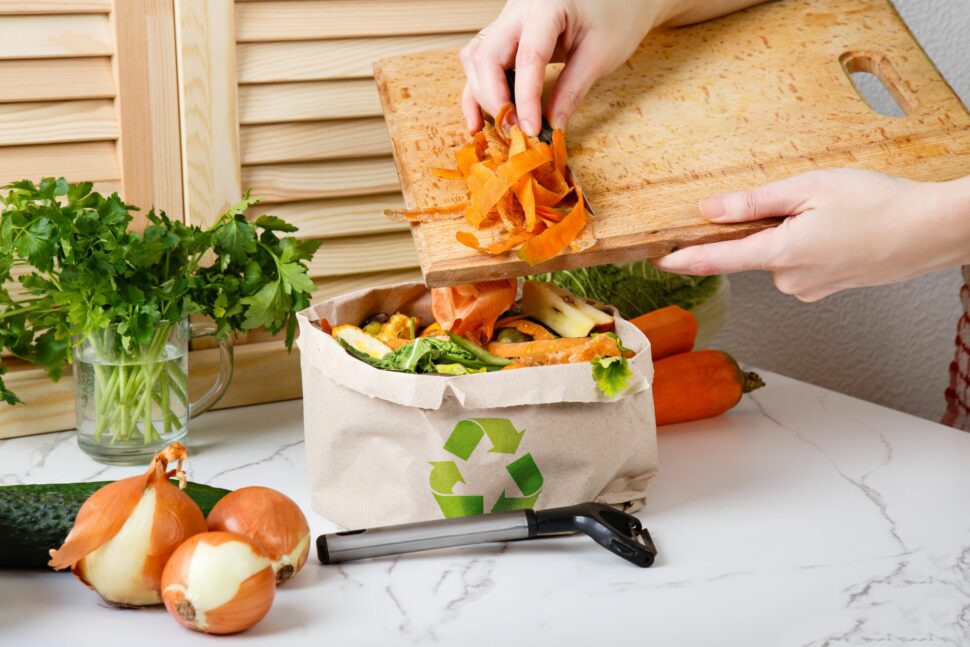- 1.How to cut food costs in restaurants
- Identify high-cost, low-profit items in your menu
- Optimize your supply chain
- Be mindful of customer food waste
- Don’t let older ingredients go to waste
- Streamline your menu
- Consider using a food cost calculator
- Do a daily inventory on the items you use most
- Minimize the number of suppliers you use
- Pre-portion ingredients for menu items
- Hunt seasonal ingredients
- Use the FIFO method
- 2.How to cut labor costs in restaurant
- 3.Cost-cutting strategy for other operational issues
- Optimize energy usage
- Take advantage of free marketing
- Consider buying used appliances and equipment
- Lock up expensive alcohol
- Go easy on the freebies
- Reduce paper use by going digital as much as possible
- 4.How to cut restaurant costs by optimizing operations
- 5.
Are your tables full every night? Do you get raving reviews? And yet, despite all the customer appreciation, do you still struggle to make a profit at the end of each month? Then it is time to make some changes that will ensure you will still run a successful business a few years from now.
Below, I will teach you how to save money as a restaurant owner without sacrificing quality or customer experience. Check out these simple cost reduction strategies in restaurants:
Cost Reduction Strategies in Restaurants
From food to labor and everything in between, here is where and how to save money in the restaurant business:
How to cut food costs in restaurants
One of the number one money wasters in restaurants is food. But if food costs are too high, what do you check first? Let’s use the food cost formula to calculate the food cost percentage:
Total cost of ingredients / Menu item price
By calculating the food cost percentage, you will find out how much money you’re spending on ingredients compared to how much you charge for each menu item. Ideally, your food cost should be somewhere between 15 and 30%, which would give you a gross revenue per item of 70 to 85%.
Read more: Restaurant Food Costs: How to Manage the Rising Inflation without Losing Customers
By exercising food cost control, you can minimize your costs and maximize your gains. What is food cost control? Simply put, it is identifying the cost of food at your restaurant and learning how to reduce it.
The food cost-saving ideas below will help you pinpoint the factors affecting food cost and eliminate them one by one. Without further ado, here’s how to reduce food cost in restaurant management.
1. Identify high-cost, low-profit items in your menu
Most restaurant menus have certain items that, despite costing a lot to make, don’t sell very well. These are what’s bleeding you dry. The good news is they are one the most controllable expenses in a restaurant.
If people aren’t into them, there’s no point in keeping them around. Wave them goodbye and replace them with items you know (or suspect) your customers would love to try.
Moreover, try to add profitable menu items to your menu, that cost very little to make, such as:
- Toppings: allow people to create the perfect menu item while increasing your revenue;
- Appetizers: smaller portions means you get to use less ingredients for the same amount of money;
- Combos: persuade people to order more than they initially wanted by creating menu combos that include a main, a side and a drink.

Read more: 7 Most Profitable Menu Items to Include in Your Restaurant Menu
2. Optimize your supply chain
Identify gaps in your supply chain that are losing you money, and as much as possible, try to stick to one provider. Paying multiple delivery fees can be detrimental to your business. If you can find a supplier selling most of the ingredients you need, give them a chance, and you might save some money.
Related: Novice Restaurateur’s Guide to Restaurant Supply Chain Management
3. Be mindful of customer food waste
Do you regularly throw away leftover food on customers’ plates? You might as well throw your money straight into the trash. Reconsider your portion sizes if most customers can’t finish them. They won’t know the difference, and you’ll stop wasting food.
Read more: How to Reduce Food Waste in Restaurants: 7 Tips & Tricks
4. Don’t let older ingredients go to waste
As long as they can still be used safely, it makes no sense to throw away perfectly good, if slightly old, ingredients. Even if the bread isn’t fresh enough to be served as such, you can always turn it into croutons. Get creative with older ingredients, and you’ll reduce food waste and costs.
Read more: 10 Zero Waste Restaurant Ideas You Must Try Right Now
5. Streamline your menu
Your menu doesn’t have to be pages long and try to cater to everyone’s tastes. In fact, the longer the menu, the less decisive and satisfied your customers will be. If your specialty is pizza, there’s no need for you to also serve burgers, pasta, barbecue, salads, and so on. Avoid the paradox of choice by simplifying your menu to focus on a few things you do well.
This will improve efficiency in the kitchen and inventory management. It will also provide customers with more high-quality meals in less time.
You might also like: Why Restaurants with Small Menus Are More Successful [+ Menu Template]
6. Consider using a food cost calculator
If you want someone else to do the hard work for you, use a food cost calculator to track food costs every day. Once this becomes a habit, you’ll start paying much more attention to how much money you spend on food.
7. Do a daily inventory on the items you use most
Daily inventory is a must-do for any restaurateur. Here is an example:
- Focus on the ten products that you constantly use and that make up most of your food cost;
- Keep a record of the quantity for each at the beginning of the workday;
- When the restaurant closes, count again to see how much of each item you’ve used.
If the number doesn’t match up with the one on your POS, it might mean you’re over proportioning, wasting food, or it might be a sign of employee theft. Restaurant management software can help you keep track of your inventory more easily.
For example, the benefits of an EPOS system include automating order management, inventory tracking, and payroll – optimizing staff efficiency and reducing labor expenses while ensuring accurate reporting and streamlined operations.
Read more: 7 Effective Restaurant Inventory Management Tips for 2024
8. Minimize the number of suppliers you use
Practice one-stop shopping when it comes to your supplies, and you might manage to lower food costs. Consolidating a relationship with a supplier means you can negotiate better prices for large quantities of products or discounts for bulk orders.
Read more: How to Choose the Best Restaurant Suppliers for Your Business
9. Pre-portion ingredients for menu items
One of the factors that affect food cost in a restaurant is employees being overly generous with ingredients. This can become a real problem if the ingredients are costly. To avoid that, pre-portion your ingredients, at least for more expensive menu items. This will also speed up service.
10. Hunt seasonal ingredients
Using seasonal ingredients has many benefits for restaurants. First, the ingredients will be fresher and tastier. Second, they’ll be cheaper, which will lower food costs. Even more, you will offer diversity to your customers, which will keep them coming back. Not to mention you will also support local farmers.
Read more: The Benefits of a Seasonal Restaurant Menu & How to Implement One
11. Use the FIFO method
The “First In, First Out” (FIFO) method is straightforward yet highly effective at lowering food costs. Avoid your food expiring before you get a chance to use it by labeling everything with its expiration date. Then, place the oldest produce in front, so your staff uses it first. That’s it!
How to cut labor costs in restaurant
According to the restaurant labor cost formula, the labor cost percentage is your labor cost divided by the total sum of your sales of the same period. Labor costs are one of the highest expenditures for any restaurant owner. Here’s how to manage labor costs better.
12. Avoid overstaffing
Overstaffing is a common problem for restaurants and one that can lead to massive money waste. Learn when your slow periods are so you don’t have employees standing around doing nothing. That said, make sure you have enough staff during rush hour to avoid the opposite effect.
13. Hire smartly
Learn how to control labor cost in your restaurant by hiring the right people from the start. But what does it mean to be the right person for your restaurant’s staff? You need employees who understand your restaurant culture and will fit in immediately.
Don’t let someone’s lack of experience deter you from hiring them. As long as they seem right for the job and are willing to be trained, it might be worth taking a chance on them. To cut labor costs, hire people who are excited to work with you and want to be there in the long run.
Cost-cutting strategy for other operational issues
Now, let’s look at cost reduction strategies in restaurants that don’t involve food or labor, but are still very important if you want to increase your profit.
14. Optimize energy usage
You can do small things to reduce energy usage that don’t take long and require no extra effort on your part. Things like these can make a difference:
- Soak dishes before washing them and only run the dishwasher when it’s full;
- When it’s nice outside, open the windows and shut down the AC to save energy;
- Replace all bulbs with energy-efficient ones and consider buying energy-efficient appliances.
Read more: How to Identify, Calculate & Reduce Restaurant Fixed Costs
15. Take advantage of free marketing
Promoting your restaurant doesn’t have to make a hole in your budget. There are a ton of free or almost free marketing ideas for restaurants that you can use. For instance, our blog contains an entire library of articles that can teach you how to market your restaurant without spending a fortune.
Read more: 10 Free Marketing Ideas for Restaurants to Implement Right Now
16. Consider buying used appliances and equipment
Buying used is one of the best cost reduction strategies in restaurants. Not all appliances have to be new. Save money and become more environmentally friendly by hunting great deals.
You may find some from restaurants and other foodservice businesses that have closed down and are looking to sell their barely-used appliances. You can also buy second-hand furniture like tables and chairs.
Read more: Restaurant Equipment List You Need to Open a Successful Restaurant
17. Lock up expensive alcohol
Employee theft is a reality that you need to be aware of. Most often, what gets stolen is expensive liquor. It’s best if you keep it locked up to avoid this happening. Keep the key yourself or give it to the manager for safekeeping.
18. Go easy on the freebies
Restaurant freebies are great, sure. But some are just useless and wasteful. For example, bulk dispensers are preferable to wrapped straws and individually wrapped salt and pepper packets.
For delivery, don’t just throw in many napkins and extra salt and pepper packets unless the customer specifically requests them. Encourage restaurant clients to be environmentally conscious and take just one napkin. This will also be profitable for you.
Read more: How to Make a Restaurant Environmentally Friendly: 5 Tips & Secrets
19. Reduce paper use by going digital as much as possible
Organizing your kitchen, inventory, and finances digitally will make your job so much easier. Not just that, but it will also reduce costs on file folders, reams of paper, and so on. Keeping digital files of everything and backing them up regularly will reduce costs and increase peace of mind.
Moreover, make the transition from a paper menu to an online restaurant menu. It has various benefits:
- Can be used by both online and in-location diners if you get a QR code and print it on flyers that you attach to every table;
- You can change it countless times at no cost, as opposed to a paper one that you have to pay for;
- You can tempt people with promotions that will appear at the start of the menu.
How to cut restaurant costs by optimizing operations
Further increase your profit by ensuring every process at your restaurant runs smoothly:
20. Implement a free online ordering system
People are now expecting restaurants to provide online ordering as hunger can strike anywhere. Investing a lot of money into an online ordering system can be a challenge for most restaurant owners. Luckily, you have a friend in GloriaFood.
You can also use chargeback protection to safeguard against fraudulent transactions. This will give your life raft that extra bit of security.
21. Optimize your menu for delivery
Not every item on your dine-in menu will be suitable for delivery. Some dishes just don’t travel well. It’s better to create a delivery-only menu with limited items because:
- This will mean fewer ingredients, so less money spent, and also less prep time;
- You will then be able to fulfill more orders in less time and earn more at the end of the day.
22. Motivate your staff
Replacing an employee is way more expensive and time-consuming than keeping an existing one happy. Therefore, if you want to know how to reduce cost in a restaurant business, start showing appreciation to your team members.
Here are a few tips:
- Offer benefits to add something extra on top of the salary;
- Incentivize employees with rewards for outstanding work;
- Ensure fair scheduling for every staff member;
- Keep employee morale up by letting them know they can come to you with any issues and making.
Read more: How to Motivate Restaurant Employees and Increase Retention
23. Try negotiating with your landlord and suppliers
Suppose you have a good relationship with your suppliers. In that case, you can negotiate the price of ingredients if you sign a contract for a longer time period.
Have you tried calling your utility company and negotiating a package deal? You can leverage your long time as a customer if that’s the case and suggest your budget might force you to switch providers.
24. Form waste-reducing habits
Like I mentioned before, habits like placing too many extra freebies in takeaway bags can lose you plenty of money. The trick is to replace these habits with waste-reducing ones that require you to pay more attention when packing a delivery bag, for instance. Don’t just do this yourself but train your staff to do it as well.
Read more: Restaurant Staff Training 101: How to Improve Efficiency with Practical Training Methods
25. Consider reducing your hours of operation
Look over your restaurant analytics and try to see if there are hours where you barely get a few clients in the restaurant. There is no need to spend money and keep the restaurant open if customers don’t usually eat at that hour. Instead:
- Identify your peak hours and keep your restaurant open only for that period;
- Reduce dining-in hours and focus on deliveries for the rest of the day.
Bottom Line
There you have it: 25 cost reduction strategies in restaurants that will boost your profits without sacrificing the customer experience. With a little bit of organization, creativity, and attention to detail, you can implement all these techniques in your restaurant. Do you have any other tips on how to cut costs in the restaurant business? Let me know!



